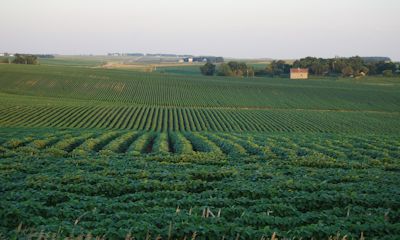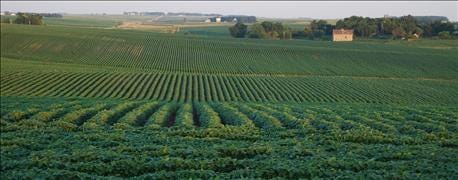
Soon, Scott Wagner will be hitting the fields to plant soybeans. "I look at soil temperatures, and if they reach 44 degrees, it's time to go," he says. Wagner, who farms near Hooper in east central Nebraska, has been planting soybeans in mid-to-late April since 2008.
He's not the only one. In 2013, Jim Specht, retired UNL professor of agronomy and horticulture, and Patricio Grassini, UNL assistant professor of agronomy and horticulture documented that, on average, Nebraska farmers are planting soybeans two weeks earlier than they did in 1980 – from an average planting date of May 25 to an average planting date of May 11.

CANOPY CLOSURE: When soybeans are planted earlier, they flower earlier, have earlier canopy closure and greater potential to capture sunlight. "The producer's job is to make sure the crop is collecting as much sun as possible. You can grab a lot of that early season sun even before the longest day of the year," says Jim Specht. "You want your soybean fields to be 'green to the eye by the Fourth of July.'" Photo credit: Don McCabe.
There are several reasons for this, including larger farm sizes that require an earlier start to planting, improved cold tolerance of soybean varieties, along with seed treatments and climate change causing soils to warm up earlier.
But it's also been shown that growers can realize higher yields by planting earlier.
Nebraska On-Farm Research Network studies at a dozen different sites from 2008, 2009, and 2010 consistently showed planting soybeans earlier, in mid-to-late April, results in higher yields – on average, about 2.7 bushels per acre higher by planting 21 days earlier.
Research conducted by Specht has found that as much as 0.25 to 0.625 (5/8) bushels per acre can be lost for every day planting is delayed after May 1.

READY TO ROLL: Research shows Nebraskans are planting soybeans two weeks earlier on average than they were 30 years ago. Some, like Scott Wagner, plant soybeans as early as mid-to-late April. "I look at soil temperatures, and if they reach 44 degrees, it's time to go," he says. "Even if it drops below 44 degrees after I've planted, I still feel that I'm okay. Soybeans can tolerate 28 degrees for four hours."
Agronomic benefits
When soybeans are planted earlier, they flower earlier, have earlier canopy closure and greater potential to capture sunlight. "The producer's job is to make sure the crop is collecting as much sun as possible. You can grab a lot of that early season sun even before the longest day of the year," Specht says. "You want your soybean fields to be 'green to the eye by the Fourth of July.' If you still see the ground at that time then some sunlight is ending up there instead of being captured by the leaves"
~~~PAGE_BREAK_HERE~~~
Planting earlier also means the plant reaches the vegetative stage earlier, meaning it has more time to create more nodes. "A new node is created by soybeans about every 3.7 days. So you get two nodes a week during the vegetative stage and that starts right after V1," Specht says. "If you're planting later, you're going to lose a few nodes. You maximize your node number by planting as early as you can. That's where the flowers, pods, and seeds are at."
In 2008, Wagner conducted an on-farm study of his own, planting soybeans on April 26, May 5, and May 15. Those planted on April 26 accrued the most nodes, while those planted on May 15 accrued the least.
So, Wagner bought another planter to plant soybeans at the same time as corn. "We're seeing a 5 to 7 bushel-per acre yield increase at a minimum by planting early," Wagner says. "It's paying for that extra planter really quickly."
Key considerations
However, there are some challenges when planting soybeans earlier, including chilling injury. Chilling injury occurs only during the imbibitional phase of water uptake by soybean seed, and this phase lasts for the first 24 to 48 hours the seed is in the ground. During this time, chilling injury occur if soil temperatures are below 45 degrees Fahrenheit, and if low moisture content seeds are put into cold ground – soybean seeds require 50% more water to germinate than corn seeds. Germination failure can occur as a result.

Another challenge is pests, including diseases and insects like bean leaf beetle. "Bean leaf beetles love early planting, so you better have an insecticide treatment on your beans," Specht says. "They feed a little bit, lay their eggs and then die. The problem is they can transmit bean pod mottle virus."
That's why it's important to plant with an insecticide and fungicide seed treatment. "We seed treat everything – and apply fungicide and insecticide on everything too. It's something we plan for that we know is going to pay and it works," Wagner says. "That was a part of the transition when we started planting earlier – before 2009, 2008, there really wasn't a lot of seed treating going on. It has definitely paid for itself, especially with early planting."
Read more in the April Nebraska Farmer.
About the Author(s)
You May Also Like






